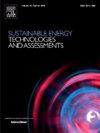利用计算机视觉改进光伏热点和污垢堆积检测:基于野外航拍图像的系统YOLO模型比较
IF 7.1
2区 工程技术
Q1 ENERGY & FUELS
Sustainable Energy Technologies and Assessments
Pub Date : 2025-05-19
DOI:10.1016/j.seta.2025.104355
引用次数: 0
摘要
光伏发电是一种重要的可再生能源,在大型光伏电站方面存在大量投资。光伏板上灰尘和其他沉积物的积累会导致热点的形成,从而严重影响系统的性能并导致光伏电池的损坏。航空图像的使用为监测光伏电站提供了一种有价值的工具,可以识别热点和污垢积聚。然而,使用有效的机器学习算法对于检测此类异常至关重要。Τhe提出了一个基于You Only Look Once (YOLO)计算机视觉算法的监控系统的实现,以解决这一需求。使用为检测热点和鸟粪分别生成的两个自定义数据集,对不同版本的YOLO模型(YOLOv5、YOLOv7、YOLOv8、yoloo - nas和YOLOv9)的性能进行了评估。这些数据集包括通过无人机收集的航空热图像和光学图像。此外,为每个单独的YOLO模型确定了最优参数集。YOLOv5表现出优异的性能,在“BIRD drop”数据集上实现了99.4%的平均精度,在“HOT SPOT”数据集上实现了99.3%的平均精度。值得注意的是,对于“热点”数据集,YOLOv8达到了99.4%的最高召回率,展示了其准确识别热点的能力。本文章由计算机程序翻译,如有差异,请以英文原文为准。
Improving photovoltaics hotspot and dirt accumulation detection with computer vision: A systematic YOLO model comparison based on field aerial images
Photovoltaics represent a significant renewable energy source, and substantial investments exist in large-scale PV plants. The accumulation of dust and other deposits on the PV panels can result in the formation of hotspots, which drastically impair the performance of the systems and cause damage to the PV cells. The use of aerial imagery provides a valuable tool for monitoring photovoltaic plants to identify hotspots and dirt accumulation. However, the employment of effective machine learning algorithms is essential for the detection of such abnormalities. Τhe implementation of a monitoring system is proposed, based on the You Only Look Once (YOLO) computer vision algorithm to address this need. The performance of various versions of YOLO models (YOLOv5, YOLOv7, YOLOv8, YOLO-NAS, and YOLOv9) was evaluated using two custom datasets generated for the detection of hotspots and bird droppings, respectively. The datasets comprise aerial thermal and optical images collected via a drone. Additionally, optimal sets of parameters were identified for each individual YOLO model. YOLOv5 demonstrated exceptional performance, achieving a mean Average Precision of 99.4% on the ’BIRD DROPPING’ dataset and 99.3% on the ’HOT SPOT’ dataset. Notably, for the ’HOT SPOT’ dataset, YOLOv8 achieved the highest recall at 99.4%, showcasing its capability in accurately identifying hotspots.
求助全文
通过发布文献求助,成功后即可免费获取论文全文。
去求助
来源期刊

Sustainable Energy Technologies and Assessments
Energy-Renewable Energy, Sustainability and the Environment
CiteScore
12.70
自引率
12.50%
发文量
1091
期刊介绍:
Encouraging a transition to a sustainable energy future is imperative for our world. Technologies that enable this shift in various sectors like transportation, heating, and power systems are of utmost importance. Sustainable Energy Technologies and Assessments welcomes papers focusing on a range of aspects and levels of technological advancements in energy generation and utilization. The aim is to reduce the negative environmental impact associated with energy production and consumption, spanning from laboratory experiments to real-world applications in the commercial sector.
 求助内容:
求助内容: 应助结果提醒方式:
应助结果提醒方式:


